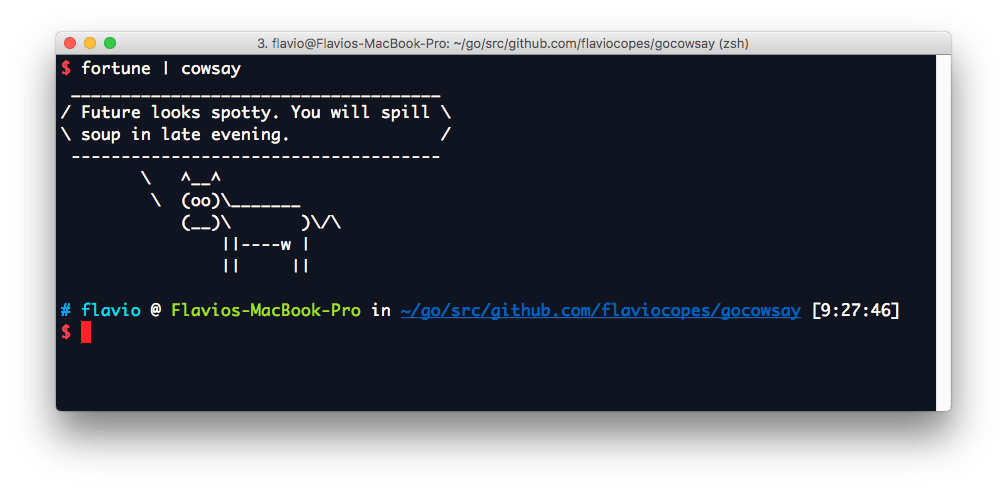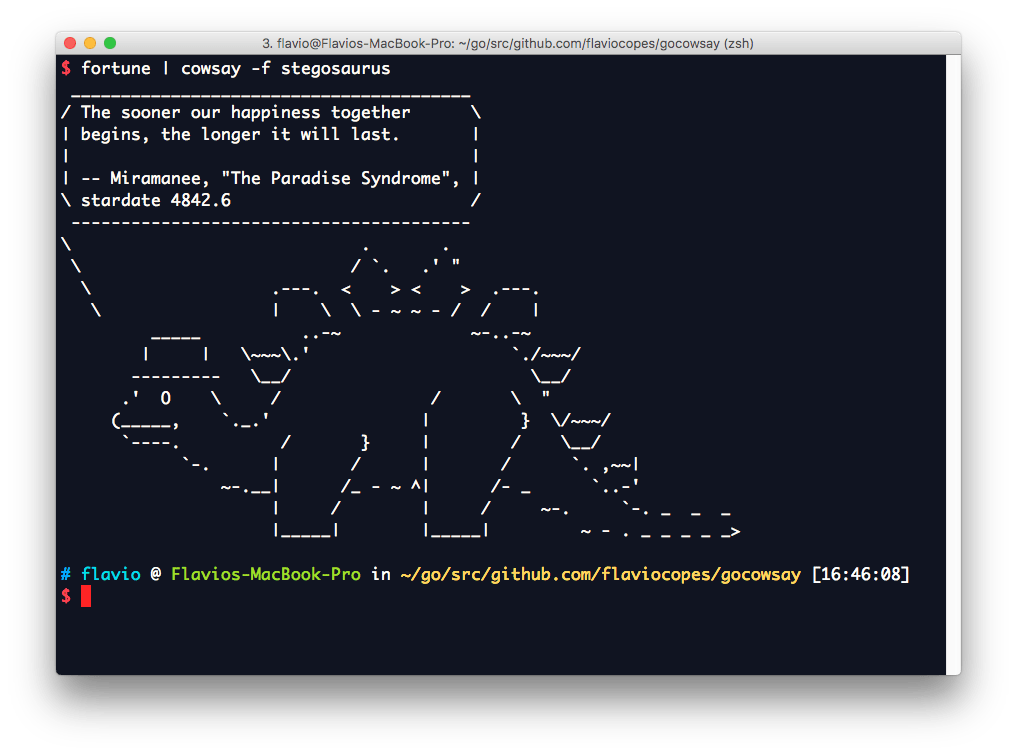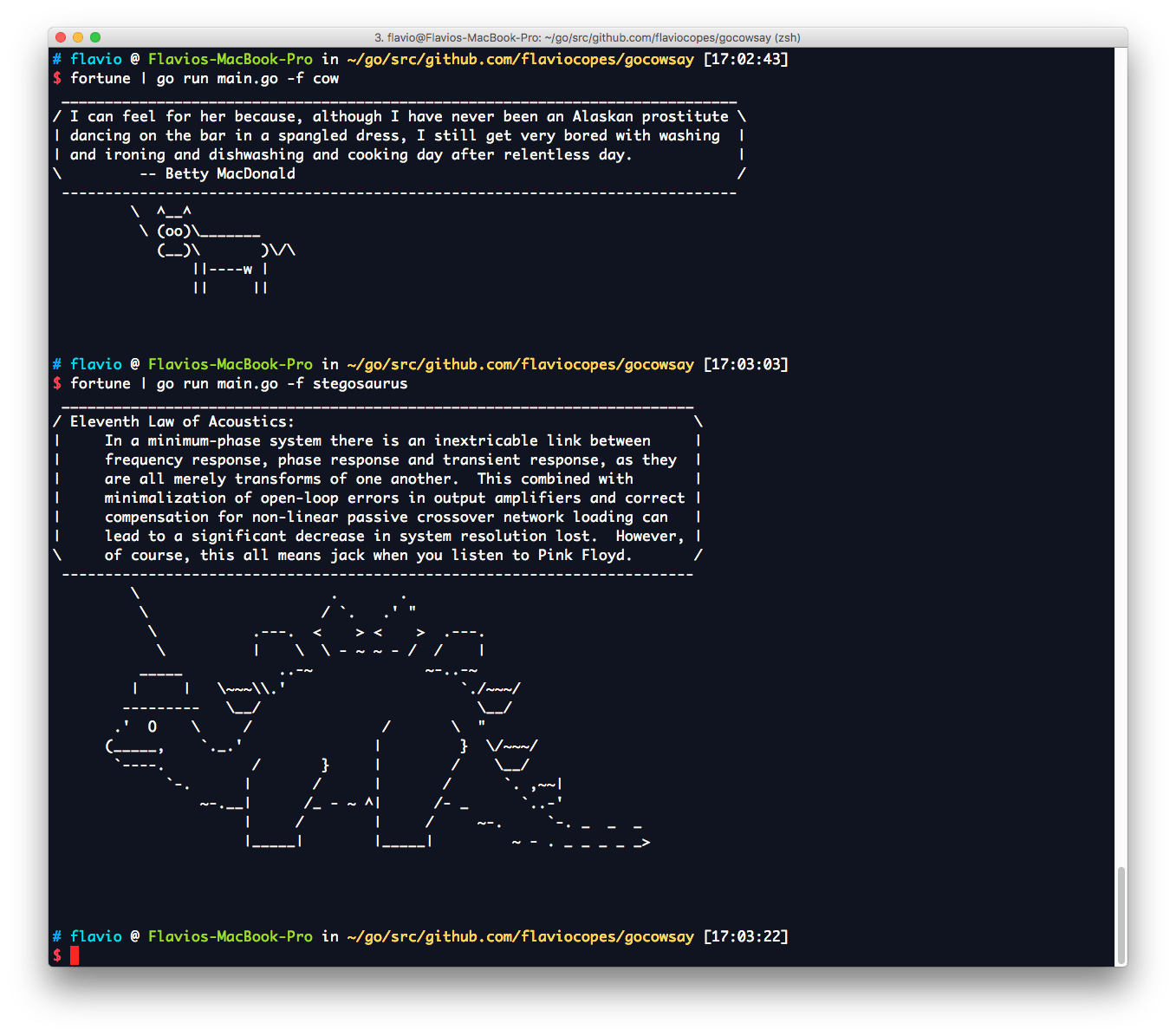Building a CLI command with Go: cowsay
Like CLI apps? Don’t miss the lolcat tutorial as well!
Cowsay is one of those apps you can’t live without.

It basically generates ASCII pictures of a cow with any message you pass it to, in the above screenshot using fortune to generate it. But it’s not limited to the cow domain, it can print penguins, mooses and many other animals.
Sounds like a useful app to port to Go!
Also, I like the plain english license attached to it:
==============
cowsay License
==============
cowsay is distributed under the same licensing terms as Perl: the
Artistic License or the GNU General Public License. If you don't
want to track down these licenses and read them for yourself, use
the parts that I'd prefer:
(0) I wrote it and you didn't.
(1) Give credit where credit is due if you borrow the code for some
other purpose.
(2) If you have any bugfixes or suggestions, please notify me so
that I may incorporate them.
(3) If you try to make money off of cowsay, you suck.Let’s start by defining the problem. We want to accept input through a pipe, and have our cow say it.
The first iteration reads the user input from the pipe, and prints it back. Not too much complicated.
package main
import (
"bufio"
"fmt"
"io"
"os"
)
func main() {
info, _ := os.Stdin.Stat()
if info.Mode()&os.ModeCharDevice != 0 {
fmt.Println("The command is intended to work with pipes.")
fmt.Println("Usage: fortune | gocowsay")
return
}
reader := bufio.NewReader(os.Stdin)
var output []rune
for {
input, _, err := reader.ReadRune()
if err != nil && err == io.EOF {
break
}
output = append(output, input)
}
for j := 0; j < len(output); j++ {
fmt.Printf("%c", output[j])
}
}
We’re missing the cow, and also we need to wrap the message into a balloon, nicely formatted.

Here is the first iteration of our program:
package main
import (
"bufio"
"fmt"
"io"
"os"
"strings"
"unicode/utf8"
)
// buildBalloon takes a slice of strings of max width maxwidth
// prepends/appends margins on first and last line, and at start/end of each line
// and returns a string with the contents of the balloon
func buildBalloon(lines []string, maxwidth int) string {
var borders []string
count := len(lines)
var ret []string
borders = []string{"/", "\\", "\\", "/", "|", "<", ">"}
top := " " + strings.Repeat("_", maxwidth+2)
bottom := " " + strings.Repeat("-", maxwidth+2)
ret = append(ret, top)
if count == 1 {
s := fmt.Sprintf("%s %s %s", borders[5], lines[0], borders[6])
ret = append(ret, s)
} else {
s := fmt.Sprintf(`%s %s %s`, borders[0], lines[0], borders[1])
ret = append(ret, s)
i := 1
for ; i < count-1; i++ {
s = fmt.Sprintf(`%s %s %s`, borders[4], lines[i], borders[4])
ret = append(ret, s)
}
s = fmt.Sprintf(`%s %s %s`, borders[2], lines[i], borders[3])
ret = append(ret, s)
}
ret = append(ret, bottom)
return strings.Join(ret, "\n")
}
// tabsToSpaces converts all tabs found in the strings
// found in the `lines` slice to 4 spaces, to prevent misalignments in
// counting the runes
func tabsToSpaces(lines []string) []string {
var ret []string
for _, l := range lines {
l = strings.Replace(l, "\t", " ", -1)
ret = append(ret, l)
}
return ret
}
// calculatemaxwidth given a slice of strings returns the length of the
// string with max length
func calculateMaxWidth(lines []string) int {
w := 0
for _, l := range lines {
len := utf8.RuneCountInString(l)
if len > w {
w = len
}
}
return w
}
// normalizeStringsLength takes a slice of strings and appends
// to each one a number of spaces needed to have them all the same number
// of runes
func normalizeStringsLength(lines []string, maxwidth int) []string {
var ret []string
for _, l := range lines {
s := l + strings.Repeat(" ", maxwidth-utf8.RuneCountInString(l))
ret = append(ret, s)
}
return ret
}
func main() {
info, _ := os.Stdin.Stat()
if info.Mode()&os.ModeCharDevice != 0 {
fmt.Println("The command is intended to work with pipes.")
fmt.Println("Usage: fortune | gocowsay")
return
}
var lines []string
reader := bufio.NewReader(os.Stdin)
for {
line, _, err := reader.ReadLine()
if err != nil && err == io.EOF {
break
}
lines = append(lines, string(line))
}
var cow = ` \ ^__^
\ (oo)\_______
(__)\ )\/\
||----w |
|| ||
`
lines = tabsToSpaces(lines)
maxwidth := calculateMaxWidth(lines)
messages := normalizeStringsLength(lines, maxwidth)
balloon := buildBalloon(messages, maxwidth)
fmt.Println(balloon)
fmt.Println(cow)
fmt.Println()
}
Let’s now make the figure configurable, by adding a stegosaurus

The original application uses the -f flag to accept a custom figure. So let’s do the same by processing a command line flag.
I briefly change the previous program to introduce printFigure()
// printFigure given a figure name prints it.
// Currently accepts `cow` and `stegosaurus`.
func printFigure(name string) {
var cow = ` \ ^__^
\ (oo)\_______
(__)\ )\/\
||----w |
|| ||
`
var stegosaurus = ` \ . .
\ / ` + "`" + `. .' "
\ .---. < > < > .---.
\ | \ \ - ~ ~ - / / |
_____ ..-~ ~-..-~
| | \~~~\\.' ` + "`" + `./~~~/
--------- \__/ \__/
.' O \ / / \ "
(_____, ` + "`" + `._.' | } \/~~~/
` + "`" + `----. / } | / \__/
` + "`" + `-. | / | / ` + "`" + `. ,~~|
~-.__| /_ - ~ ^| /- _ ` + "`" + `..-'
| / | / ~-. ` + "`" + `-. _ _ _
|_____| |_____| ~ - . _ _ _ _ _>
`
switch name {
case "cow":
fmt.Println(cow)
case "stegosaurus":
fmt.Println(stegosaurus)
default:
fmt.Println("Unknown figure")
}
}and changing main() to accept a flag and passing it to printFigure():
func main() {
//...
var figure string
flag.StringVar(&figure, "f", "cow", "the figure name. Valid values are `cow` and `stegosaurus`")
flag.Parse()
//...
printFigure(figure)
fmt.Println()
}
I think we’re at a good point. I just want to make this usable system-wise, without running go run main.go, so I’ll just type go build and go install.
I can now spend the day with gololcat and gocowsay

download all my books for free
- javascript handbook
- typescript handbook
- css handbook
- node.js handbook
- astro handbook
- html handbook
- next.js pages router handbook
- alpine.js handbook
- htmx handbook
- react handbook
- sql handbook
- git cheat sheet
- laravel handbook
- express handbook
- swift handbook
- go handbook
- php handbook
- python handbook
- cli handbook
- c handbook
subscribe to my newsletter to get them
Terms: by subscribing to the newsletter you agree the following terms and conditions and privacy policy. The aim of the newsletter is to keep you up to date about new tutorials, new book releases or courses organized by Flavio. If you wish to unsubscribe from the newsletter, you can click the unsubscribe link that's present at the bottom of each email, anytime. I will not communicate/spread/publish or otherwise give away your address. Your email address is the only personal information collected, and it's only collected for the primary purpose of keeping you informed through the newsletter. It's stored in a secure server based in the EU. You can contact Flavio by emailing flavio@flaviocopes.com. These terms and conditions are governed by the laws in force in Italy and you unconditionally submit to the jurisdiction of the courts of Italy.